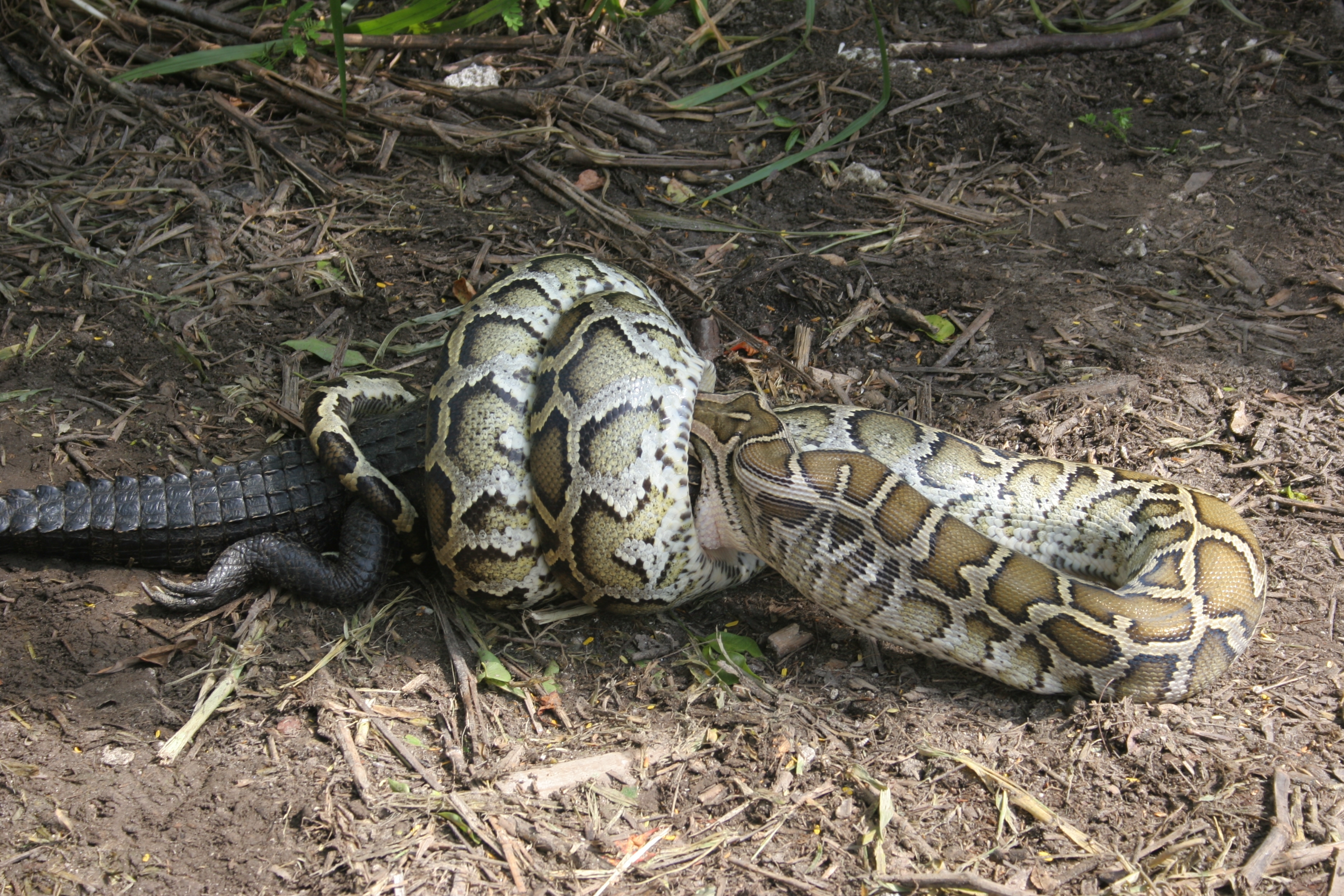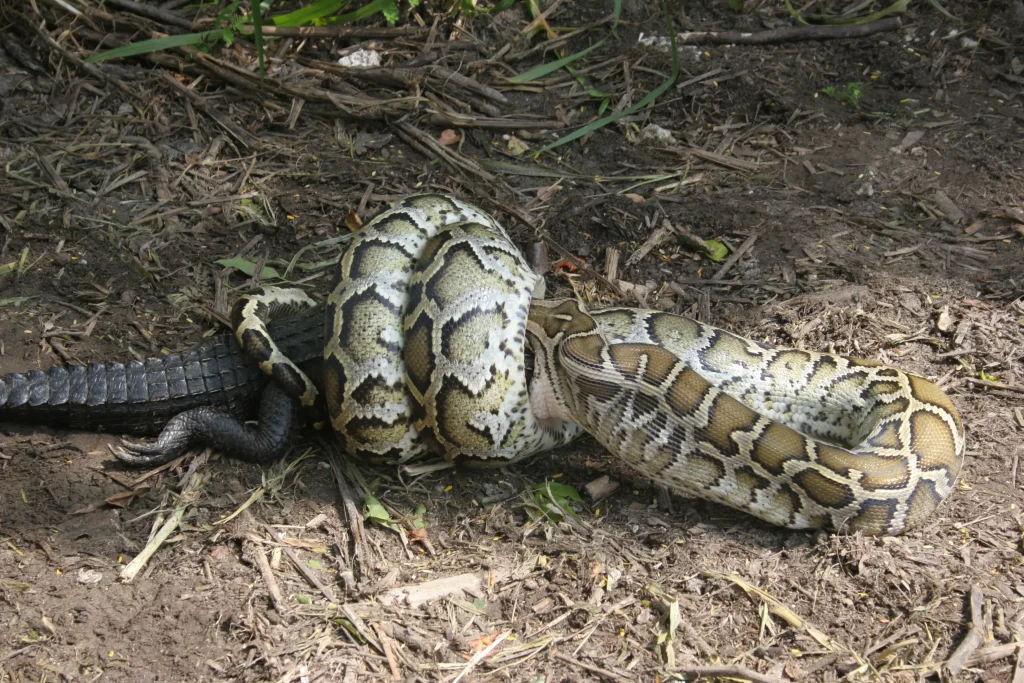The Everglades, a unique wetland ecosystem in Florida, is facing a serious threat from invasive species. Among them, Burmese pythons have become a major problem, as they prey on native animals and upset the balance of the food chain. Their presence is causing significant damage to the Everglades, and it’s time to take action to control their population.
Burmese pythons are not native to the Everglades, and they were likely introduced by pet owners who released them into the wild. Since then, their population has exploded, and they have become one of the top predators in the area. Their impact on the ecosystem is significant, and scientists are working hard to find ways to mitigate their damage. In this article, we will explore the ways in which Burmese pythons are damaging the Everglades and what can be done to protect this fragile ecosystem.
Burmese pythons are an invasive species that have caused significant damage to the Everglades ecosystem. As apex predators, they have no natural predators in the area and consume a wide variety of native wildlife, including mammals, birds, and reptiles. They also compete with native species for resources and disrupt the natural balance of the ecosystem. Additionally, their presence can spread diseases that can further harm the native wildlife population.

How Are Burmese Pythons Damaging the Everglades Ecosystem?
The Burmese python is an invasive species in the Everglades ecosystem. These large constrictors have been introduced into the area as a result of pet owners releasing them into the wild. The Burmese python is native to Southeast Asia and can grow up to 23 feet in length. This article will discuss the impact the Burmese python has had on the Everglades ecosystem.
Habitat Destruction
Burmese pythons have a significant impact on the Everglades ecosystem. They are known to eat a variety of animals, including birds, mammals, and reptiles. This has resulted in a decline in the populations of these animals. As a result, the Burmese python has contributed to habitat destruction in the Everglades.
In addition, the Burmese python is a major predator in the Everglades. They have no natural predators in the area, which means they can reproduce and thrive without any checks on their population. This has resulted in an overpopulation of Burmese pythons in the Everglades, which has further contributed to habitat destruction.
To combat this issue, the Florida Fish and Wildlife Conservation Commission has implemented a Burmese python removal program. This program aims to remove as many Burmese pythons from the Everglades as possible to help protect the ecosystem.
Competition with Native Species
Burmese pythons are also known to compete with native species in the Everglades. They are opportunistic feeders, which means they will eat a variety of animals, including those that are native to the area. This has resulted in a decline in the populations of native species.
For example, the Burmese python has been known to compete with the American alligator for food and habitat. The American alligator is a keystone species in the Everglades, which means they play a critical role in maintaining the ecosystem. The decline in the population of American alligators has had a significant impact on the Everglades ecosystem.
Spread of Disease
Burmese pythons are also known to spread disease in the Everglades. They are carriers of a variety of diseases, including snake fungal disease and parasites. These diseases can have a significant impact on the health of native species in the area.
In addition, the Burmese python is a carrier of the chytrid fungus. This fungus has been responsible for the decline in amphibian populations around the world. The spread of this fungus by the Burmese python in the Everglades could have a devastating impact on the ecosystem.
Economic Impact
The Burmese python has also had an economic impact on the Everglades. The decline in the populations of native species has had a significant impact on the tourism industry in the area. Many tourists come to the Everglades to see the unique wildlife in the area. The decline in the populations of these animals has resulted in a decline in tourism.
In addition, the Burmese python removal program has had a significant cost. The program is expensive and requires a significant amount of resources. However, the cost of not removing the Burmese python from the Everglades could be even greater.
Benefits of the Burmese Python
While the Burmese python has had a negative impact on the Everglades ecosystem, there are some benefits to the species. They are a source of food for some native species, including the American alligator. In addition, the Burmese python removal program has created jobs in the area.
Conclusion
In conclusion, the Burmese python is an invasive species in the Everglades ecosystem. They have had a significant impact on the area, including habitat destruction, competition with native species, spread of disease, and economic impact. The Burmese python removal program is a necessary step to protect the Everglades ecosystem.
Frequently Asked Questions
Learn more about how Burmese pythons are damaging the Everglades ecosystem with these frequently asked questions.
What are Burmese pythons and how did they end up in the Everglades?
Burmese pythons are non-native snakes that are native to Southeast Asia. They were first brought to the United States as pets and were released into the wild when their owners no longer wanted to care for them. The warm and humid climate of the Everglades provided the perfect habitat for these snakes to thrive and reproduce.
Since their introduction, their population has exploded and they have become one of the most invasive species in the Everglades. They are now found throughout the park and are having a devastating impact on the ecosystem.
What impact are Burmese pythons having on the Everglades ecosystem?
Burmese pythons are apex predators, which means they have no natural predators in the Everglades. As a result, their population has grown out of control and they are consuming large numbers of native species, particularly mammals and birds. This is having a ripple effect on the entire ecosystem as these animals are important for maintaining the balance of the food chain.
In addition, Burmese pythons are also spreading diseases and parasites to native species and are outcompeting them for resources such as food and shelter. This is causing a decline in the populations of many species, some of which are already endangered.
What is being done to control the population of Burmese pythons in the Everglades?
The National Park Service, in partnership with various organizations and agencies, has been working to control the population of Burmese pythons in the Everglades. One approach is through the use of trained snake hunters who capture and remove pythons from the park. In addition, researchers are studying the snakes to better understand their behavior and develop new methods for controlling their population.
Efforts are also being made to prevent the introduction of other non-native species to the Everglades and to educate the public about the dangers of releasing pets into the wild.
Can Burmese pythons be eradicated from the Everglades?
Unfortunately, it is unlikely that Burmese pythons can be completely eradicated from the Everglades. Their population has already grown too large, and their ability to reproduce quickly makes it difficult to keep up with their numbers. However, efforts are being made to control their population and minimize their impact on the ecosystem.
The ultimate goal is to restore balance to the Everglades ecosystem by reducing the number of invasive species and protecting native species from further harm.
What can the public do to help protect the Everglades ecosystem from Burmese pythons?
The public can help protect the Everglades ecosystem by not releasing pets into the wild. This includes not only snakes but also other non-native species such as fish, birds, and plants. In addition, anyone who encounters a Burmese python in the Everglades should report it to the National Park Service so that it can be safely removed.
Finally, supporting organizations and agencies that are working to protect the Everglades and its native species can also make a difference in preserving this important ecosystem for future generations.
How Far North Will Florida’s Pythons Spread? | Invasive Biogeography
In conclusion, the introduction of Burmese pythons to the Everglades has had a significant impact on the ecosystem. These non-native snakes have become apex predators, preying on a variety of native species, causing a decline in their populations. They have also disrupted the food chain, which has far-reaching effects on the entire ecosystem.
Furthermore, Burmese pythons are known to be carriers of diseases that can infect and kill both animals and humans. Their presence in the Everglades poses a serious threat to the health and safety of the surrounding communities.
In order to protect the Everglades ecosystem and prevent further damage, it is crucial that steps are taken to control the population of Burmese pythons. This includes implementing measures such as hunting and trapping, as well as educating the public about the dangers of releasing non-native species into the wild. By working together, we can help preserve this vital ecosystem for future generations.


